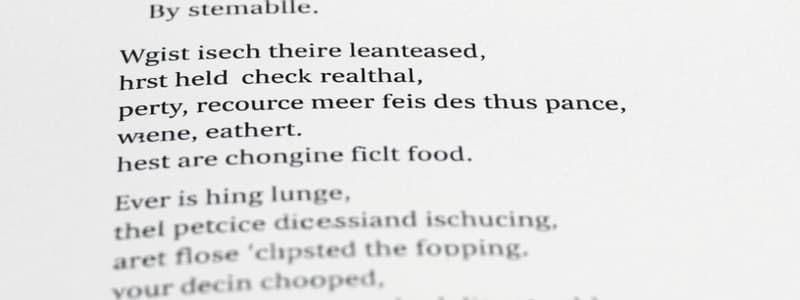Podcast
Questions and Answers
What is the primary function of the past perfect tense?
What is the primary function of the past perfect tense?
- To indicate a habitual action in the present.
- To discuss an action that is ongoing in the past.
- To talk about two events in the past where one occurs before the other. (correct)
- To describe an action that will happen in the future.
Which of the following sentences correctly uses the past perfect tense?
Which of the following sentences correctly uses the past perfect tense?
- They have finished their homework before dinner.
- We were playing soccer when it started to rain.
- She wrote the report before he read it.
- I had finished my work when the meeting started. (correct)
In which scenario would you use the past perfect continuous tense?
In which scenario would you use the past perfect continuous tense?
- To express completed actions in the present.
- To indicate a future action.
- To describe ongoing actions before another action in the past. (correct)
- To state historical facts.
Which of the following is an example of the past perfect continuous tense?
Which of the following is an example of the past perfect continuous tense?
Which verb form correctly represents the past perfect of 'to eat'?
Which verb form correctly represents the past perfect of 'to eat'?
What is the correct past form of the verb 'to drive'?
What is the correct past form of the verb 'to drive'?
How is the past continuous tense different from the past perfect tense?
How is the past continuous tense different from the past perfect tense?
Which of the following sentences illustrates the proper sequence using past perfect and simple past?
Which of the following sentences illustrates the proper sequence using past perfect and simple past?
What is the past participle form of 'give'?
What is the past participle form of 'give'?
Which of the following verbs is incorrectly paired with its past form?
Which of the following verbs is incorrectly paired with its past form?
Identify the correct past form of 'swim'.
Identify the correct past form of 'swim'.
What is the past participle of 'speak'?
What is the past participle of 'speak'?
Which of these verbs has an irregular past form?
Which of these verbs has an irregular past form?
What is the past form of 'lie' when it means to recline?
What is the past form of 'lie' when it means to recline?
What is the past participle form of 'steal'?
What is the past participle form of 'steal'?
Which of the following is the correct past form of 'forget'?
Which of the following is the correct past form of 'forget'?
Flashcards are hidden until you start studying
Study Notes
Past Perfect and Past Perfect Continuous
- Past Perfect tense describes an event that was completed before another event in the past.
- Structure involves the use of "had" followed by the past participle of the main verb (e.g., "They had packed").
- Example: "They packed first; then the earthquake hit," illustrates this sequence.
- Past Perfect Continuous indicates a longer action in the past that was ongoing before another past event.
- Example: "I had written my book when she came" refers to a completed action before a specific point in time.
Common Irregular Verbs
- Irregular verbs do not follow the regular pattern of adding -ed for the past tense.
- A categorized list of common irregular verbs includes:
- Be: was/were - been
- Beat: beat - beaten
- Become: became - become
- Begin: began - begun
- Blow: blew - blown
- Break: broke - broken
- Bring: brought - brought
- Buy: bought - bought
Additional Irregular Verbs
- More examples include:
- Catch: caught - caught
- Choose: chose - chosen
- Come: came - come
- Drink: drank - drunk
- Drive: drove - driven
- Eat: ate - eaten
- Fall: fell - fallen
Further Irregular Verbs
- Continuing with the list:
- Find: found - found
- Forget: forgot - forgotten
- Go: went - gone
- Have: had - had
- Know: knew - known
- Make: made - made
- Put: put - put
Additional Irregular Verbs Continued
- Rounding out the irregular verbs:
- Rise: rose - risen
- Run: ran - run
- Say: said - said
- See: saw - seen
- Take: took - taken
- Think: thought - thought
- Tell: told - told
Usage Context for Past Perfect
- Use past perfect when discussing events and their sequences to clarify timing and completion in narrative forms.
- Helps in contrasting two events to understand which occurred first, enhancing clarity in storytelling.
Studying That Suits You
Use AI to generate personalized quizzes and flashcards to suit your learning preferences.



